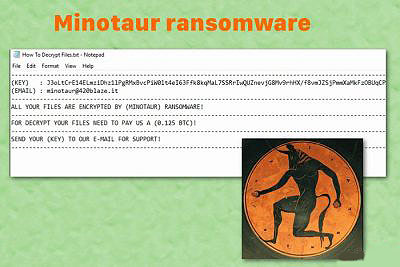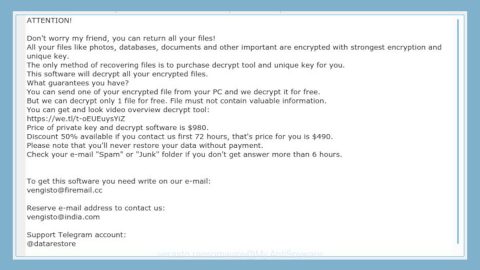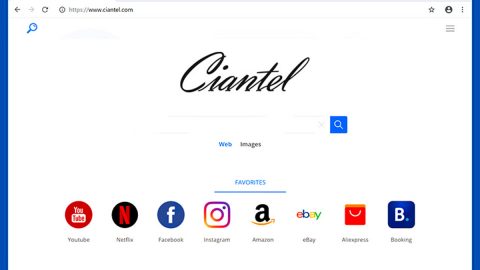What is Minotaur ransomware? And how does it carry out its attack?
Minotaur ransomware is a file-encrypting threat that was discovered in the first half of October 2018. It seems to be targeting English-speaking users but could also affect other users all over the globe. The instant it enters a targeted computer, it drops its malicious payload and connects the system to a remote server. After that, it creates and downloads more malicious files and places them on system folders.

Afterward, it proceeds to make modifications in the Windows Registry by modifying some existing registry keys like RunOnce as well as creating new ones to allow it to run on every system boot automatically. It then scans the computer for files with specific formats such as:
.3dm, .3g2, .3gp, .7zip, .aaf, .accdb, .aep, .aepx, .aet, .ai, .aif, .as, .as.txt, .as3, .asf, .asp, .asx, .avi, .bmp, .c, .class, .cpp, .cs, .csv, .dat, .db, .dbf, .doc, .docb, .docm, .docx, .dot, .dotm, .dotx, .dwg, .dxf, .dxf.c, .efx, .eps, .fla, .flv, .gif, .h, .idml, .iff, .indb, .indd, .indl, .indt, .inx, .jar, .java, .jpeg, .jpg, .js, .m3u, .m3u8, .m4u, .max, .mdb, .mid, .mkv, .mov, .mp3, .mp4, .mpa, .mpeg, .mpg, .msg, .pdb, .pdf, .php, .plb, .pmd, .png, .pot, .potm, .potx, .ppam, .ppj, .pps, .ppsm, .ppsx, .ppt, .pptm, .pptx, .prel, .prproj, .ps, .psd, .py, .ra, .rar, .raw, .rb, .rtf, .sdf, .ses, .sldm, .sldx, .sql, .svg, .swf, .tif, .txt, .vcf, .vob, .wav, .wma, .wmv, .wpd, .wps, .xla, .xlam, .xll, .xlm, .xls, .xlsb, .xlsm, .xlsx, .xlt, .xltm, .xltx, .xlw, .xml, .xqx, .zip
Once it finds the targeted files, it encrypts them using the AES encryption algorithm and appends the .lock extension. It then releases a text file named “How To Decrypt Files.txt” which contains the following message:
“—————————————————————————————-
(KEY) : J3oLtCrE14ELmziDhz1lPgRMxBvcPiW01t4eI63Ffk8kqMaL7SSRrI***
(EMAIL) : minotaur0428blaze.it
—————————————————————————————-
ALL YOUR FILES ARE ENCRYPTED BY (MINOTAUR) RANSOMWARE!
—————————————————————————————-
TO DECRYPT YOUR FILES NEED TO PAY US A (0.125 BTC)!
—————————————————————————————-
FILES ARE ENCRYPTED BY (MINOTAUR) RANSOMWARE!
—————————————————————————————-”
As you can see, the crooks behind Minotaur ransomware demands a ransom of 0.125BTC in exchange for file recovery. However, you must not give in to these crooks’ demands as you might only end up losing money for nothing. The best thing you can do right now is to delete this crypto-malware from your computer and then try alternative ways to restore your encrypted files without having to pay the ransom.
How does Minotaur ransomware circulate over the web?
Like other crypto-malware, Minotaur ransomware spreads using spam emails. The spam email may contain a link that could redirect you to the download page of the malware or it may contain some harmful attachment that instantly installs Minotaur ransomware once you open it. So when opening emails, no matter who the sender is, you must take extra precautions first.
Delete Minotaur ransomware by following the removal guide prepared below.
Step_1: The first thing you need to do is to kill the malicious process of Minotaur ransomware by opening the Task Manager – simply tap the Ctrl + Shift + Esc keys on your keyboard.
Step_2: After that, click the Processes tab and look for the suspicious-looking process that takes up most of your CPU’s resources and is most likely related to Minotaur ransomware and then end them all.
Step_3: Now that the malicious process is eliminated, close the Task Manager.
Step_4: Next, tap Win + R, type in appwiz.cpl and click OK or tap Enter to open Programs and Features under Control Panel.
Step_5: Under the list of installed programs, look for Minotaur ransomware or anything similar and then uninstall it.
Step_6: Then close Control Panel and tap Win + E keys to launch File Explorer.
Step_7: Navigate to the following locations below and look for Minotaur ransomware’s malicious components such as Minotaur.exe, [random].exe, and How To Decrypt Files.txt as well as other suspicious files it has created and downloaded into the system and then delete all of them.
- %APPDATA%
- %TEMP%
- %WINDIR%\System32\Tasks
- %APPDATA%\Microsoft\Windows\Templates\
- %USERPROFILE%\Downloads
- %USERPROFILE%\Desktop
Step_8: Close the File Explorer.
Before you go on any further, make sure that you are tech-savvy enough to the point where you know exactly how to use and navigate your computer’s Registry. Keep in mind that any changes you make will highly impact your computer. To save you the trouble and time, you can just use Restoro this system tool is proven to be safe and excellent enough that hackers won’t be able to hack into it. But if you can manage Windows Registry well, then by all means go on to the next steps.
Step_9: Tap Win + R to open Run and then type in Regedit in the field and tap enter to pull up Windows Registry.
Step_10: Navigate to the following path:
- HKEY_CURRENT_USER\Control Panel\Desktop\
- HKEY_USERS\.DEFAULT\Control Panel\Desktop\
- HKEY_LOCAL_MACHINE\Software\Microsoft\Windows\CurrentVersion\Run
- HKEY_CURRENT_USER\Software\Microsoft\Windows\CurrentVersion\Run
- HKEY_LOCAL_MACHINE\Software\Microsoft\Windows\CurrentVersion\RunOnce
- HKEY_CURRENT_USER\Software\Microsoft\Windows\CurrentVersion\RunOnce
Step_11: Delete the registry keys and sub-keys created by Minotaur ransomware.
Step_12: Close the Registry Editor and empty the Recycle Bin.
Try to recover your encrypted files using the Shadow Volume copies
Restoring your encrypted files using Windows Previous Versions feature will only be effective if Minotaur ransomware hasn’t deleted the shadow copies of your files. But still, this is one of the best and free methods there is, so it’s definitely worth a shot.
To restore the encrypted file, right-click on it and select Properties, a new window will pop up, then proceed to Previous Versions. It will load the file’s previous version before it was modified. After it loads, select any of the previous versions displayed on the list like the one in the illustration below. And then click the Restore button.
Congratulations, you have just removed Minotaur Ransomware in Windows 10 all by yourself. If you would like to read more helpful articles and tips about various software and hardware visit fixmypcfree.com daily.
Now that’s how you remove Minotaur Ransomware in Windows 10 on a computer. On the other hand, if your computer is going through some system-related issues that have to get fixed, there is a one-click solution known as Restoro you could check out to resolve them.
This program is a useful tool that could repair corrupted registries and optimize your PC’s overall performance. Aside from that, it also cleans out your computer for any junk or corrupted files that help you eliminate any unwanted files from your system. This is basically a solution that’s within your grasp with just a click. It’s easy to use as it is user-friendly. For a complete set of instructions in downloading and using it, refer to the steps below
Perform a full system scan using Restoro. To do so, follow the instructions below.













